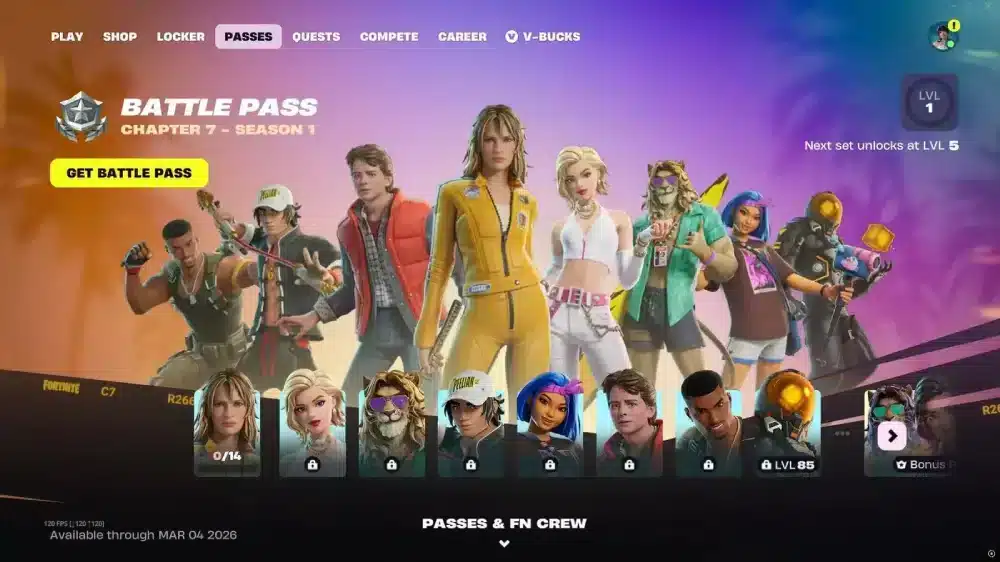Since May 2023, Fortnite introduced a ranked system that gave players a new way to measure skill and track progress. The addition of Fortnite ranked levels brought more structure to competitive matches, making every elimination and placement more meaningful.
For those aiming for higher ranks, maintaining a stable connection is key. This guide to reducing ping in Fortnite helps players achieve smoother matches and fewer interruptions.
This complete guide covers all ranked tiers, how the progression system works, and key tips to climb faster. Whether you’re stuck in Gold or aiming for Unreal, you’ll find the strategies and breakdowns you need here.
What Are the Ranked Levels in Fortnite?
Since its launch in 2023, the Fortnite ranked levels system has become a core component of competitive gameplay. It organizes players by skill, ensuring more balanced and rewarding matches for both casual and high-level players.
Because each rank reflects performance and progress, understanding the Fortnite ranks list is essential for players aiming to climb. Below, we explain the structure and naming of all Fortnite ranks, including tier breakdowns and subdivisions.
Ultimately, this section will help you identify your current level, recognize your next goals and understand the logic behind the Fortnite rank names.
Main Tiers and Progression Structure
To begin, Fortnite’s competitive mode includes a tiered structure with gradual progression. Players move from Bronze to Unreal, each step marking a higher skill bracket.
Each of the first five tiers — Bronze, Silver, Gold, Platinum, and Diamond — is divided into three subdivisions: I (lowest), II, and III (highest). From Elite upward, ranks become exclusive and do not have subdivisions.
This tiered progression adds clarity and fairness to the Fortnite ranked levels, rewarding consistent improvement.
Full Fortnite Ranks Table
Here is a breakdown of the Fortnite ranks list, their subdivisions and competitive implications:
| Tier | Subdivisions | Description |
| Bronze | I, II, III | Entry-level rank; ideal for new or casual players |
| Silver | I, II, III | Slightly more skilled; basic knowledge of game mechanics |
| Gold | I, II, III | Intermediate level; strategic understanding and combat skills |
| Platinum | I, II, III | Advanced tier; demonstrates tactical gameplay and consistency |
| Diamond | I, II, III | High-skill level; tight execution and competitive awareness |
| Elite | — | Top 1% of ranked players; strong placement and elimination performance |
| Champion | — | One of the highest competitive ranks; requires peak mechanical mastery |
| Unreal | — | The ultimate rank; only the best players in the world achieve this level |
How Does the Fortnite Progression System Work?

Because progression is the backbone of Fortnite ranked levels, understanding how it works is key to climbing efficiently and avoiding demotion.
Since the system considers individual and team performance, players should master all aspects of the Fortnite rank system to move up consistently and secure better placements in the competitive structure.
Ultimately, the following breakdown will explain how does Fortnite ranked work and why your match results matter more than ever.
Core Metrics That Influence Rank
To begin, the progression in Fortnite ranked levels is based on three major performance factors: eliminations, placement, and overall team outcome.
While eliminations grant points based on impact, strong placements (especially top 10 finishes) accelerate your advancement in the Fortnite rank system.
Moreover, assisting your squad with revives, team eliminations, and shared strategies contributes to overall rank movement — even in team-based ranked lobbies.
How Rank Increases (Or Drops)
Because all Fortnite ranks operate on performance brackets, players who perform consistently in eliminations and placements tend to rise faster.
After a series of strong matches, you’ll progress from subdivision III to I and then into the next major tier listed in the Fortnite ranks list.
However, frequent early eliminations, match abandonments, or poor team coordination can result in a drop in the Fortnite ranked levels, especially in tiers like Platinum or Diamond where competition is tighter.
What Affects Rank Gains Most?
Certainly, not all actions have the same weight in the Fortnite competitive ranks formula. Placement carries more influence than single eliminations in most cases.
Consequently, it’s better to survive longer than to play too aggressively early-game, especially when trying to stabilize your standing within higher Fortnite rank names like Elite or Champion.
By understanding how does Fortnite ranked work, you gain more control over your match strategy and improve your chances of climbing efficiently.
Differences Between Ranked Modes

Because Fortnite offers two ranked experiences — Battle Royale and Zero Build — understanding their distinct characteristics is essential for improving in the Fortnite ranked levels system.
Although both modes share progression and tiers, the playstyle, mechanics, and pacing significantly affect your strategy in the Fortnite competitive ranks landscape.
Ranked Battle Royale: Building and Strategy
To begin, Ranked Battle Royale includes Fortnite’s signature building mechanic, making it the preferred mode for players who excel in construction-based combat.
Because success in this mode relies heavily on editing speed, box fights, and vertical movement, it favors those who’ve mastered the more complex elements of the Fortnite rank system.
Furthermore, competitive play here demands resource management and high-level mechanical skill, which often determines movement within all Fortnite ranks — especially from Platinum upward.
Ranked Zero Build: Positioning and Gunplay
On the other hand, Zero Build ranked emphasizes gunfights, cover usage, and strategic movement, removing all building features entirely.
Since cover and positioning become crucial, this version appeals to players more familiar with traditional shooters but still functions under the same Fortnite ranks list structure.
Moreover, players climbing in Zero Build still move through identical Fortnite ranked levels, meaning competitive integrity is preserved regardless of mode preference.
Matchmaking and Difficulty Balance
Because each mode has separate queues, Fortnite competitive ranks are calculated independently between Battle Royale and Zero Build.
Consequently, reaching Champion rank in one mode doesn’t affect your progress in the other, encouraging players to specialize or experiment without penalty.
Additionally, matchmaking adapts to your mode-specific performance, ensuring balanced lobbies aligned with your Fortnite rank names in each environment.
Competitive Popularity and Player Base
Undoubtedly, Battle Royale remains the more competitive of the two, with a larger presence in official tournaments and events.
However, Zero Build continues to grow in popularity among casual and returning players due to its simplicity and fast-paced matches — a valid route through the Fortnite ranked levels system.
Ultimately, choosing your ranked path depends on your strengths, whether that’s building dominance or tactical shooter-style combat.
Tips to Rank Up Faster

Because climbing through the Fortnite ranked levels requires consistency and strategy, mastering key mechanics and avoiding common mistakes can drastically improve your progression.
Although the climb may seem tough, small optimizations in your gameplay and preparation can help you move up the Fortnite ranks list more efficiently.
20 Fortnite Tips to ACTUALLY Get Better..
Mastering Positioning and Loot Management
To begin, smart positioning gives you a massive advantage in ranked matches, especially when fighting players from higher Fortnite competitive ranks.
Since rotating early to high ground and controlling the zone allows for better vision and defense, it’s essential to avoid hot drops and contested zones where early chaos is likely.
Moreover, collecting high-quality loot — especially shields, mobility items, and long-range weapons — can make the difference between a clean win and an early elimination in any Fortnite rank system.
Effective Team Communication and Coordination
Because duos and squads rely heavily on synergy, playing with a coordinated team improves survival odds at every stage of the match.
In addition, sharing resources, calling out enemy positions, and planning rotations together will help maintain consistency across multiple games, especially as you aim to advance in all Fortnite ranks.
Therefore, using voice chat or pings effectively makes a noticeable difference in your overall rank performance and experience.
Avoid Peak Hours and Overcrowded Zones
Since ranked matchmaking can vary based on time zones, playing during off-peak hours often reduces encounters with high-level “tryhard” players in upper Fortnite ranked levels.
Consequently, late nights or weekday mornings might offer more balanced lobbies where strategic play matters more than raw mechanical skill.
Also, choosing safer drop spots allows you to farm materials and loot without early conflict, increasing your survival rate and chances to progress in the Fortnite ranks list.
Use Tools to Track and Analyze Performance
Because staying aware of your progress is key, external tools like Fortnite.GG allow players to view match stats, heat maps, and detailed breakdowns across Fortnite rank names.
Additionally, reviewing your performance can help identify weak spots — whether in building, aim, or positioning — letting you adjust tactics to suit your current placement in the Fortnite rank system.
Ultimately, constant review and adjustment are what separate average players from those who climb consistently through Fortnite ranked levels.
FAQ – Frequently Asked Questions
Many players still have doubts about how Fortnite ranked levels work, so we’ve gathered the most frequently asked questions to clarify the system, strategies, and progression tips.
Although ranking up can feel complex, understanding these basics helps improve both your performance and overall experience in competitive Fortnite modes.
🟫 Bronze I–III
⬜ Silver I–III
🟨 Gold I–III
⬛ Platinum I–III
💠 Diamond I–III
🔥 Elite (no divisions)
⭐ Champion (no divisions)
🌟 Unreal (top rank with global leaderboard)
These represent the full Fortnite ranks list, covering all skill tiers and Fortnite rank names available in ranked modes.
Players earn or lose rank based on:
Match placement
Number of eliminations
Team performance
Since it uses skill-based matchmaking, players are placed against others in similar Fortnite ranked levels to ensure fair, competitive matches.
These are the main factors:
High placements
Elimination count
Staying alive longer
Assisting teammates
Winning ranked matches
Because Fortnite rank system progress isn’t public, consistent gameplay is the safest path to climb.
Yes, they are tracked separately. Since each mode requires different strategies and skill sets, your Fortnite competitive ranks in Battle Royale don’t affect Zero Build, and vice versa. Therefore, players need to grind ranks independently in each playlist.
Here are the best practices:
Avoid hot drops and rotate early
Practice building and positioning
Communicate with teammates
Play during off-peak hours
Use tools like Fortnite.GG
Optimize connection with ExitLag
Consistently applying these strategies helps you rise through all Fortnite ranks efficiently.
Ready to Climb Without Lag? Optimize Your Competitive Edge
Because ranked mode rewards both skill and strategy, every advantage matters when climbing the ladder.
Therefore, reducing ping and stabilizing your connection can be the game-changer that separates a Bronze from an Unreal finish.
With ExitLag, you minimize packet loss, reduce latency, and ensure each ranked match runs smoothly—especially when it counts most. In short, a better connection means better results across all your Fortnite ranked levels.




